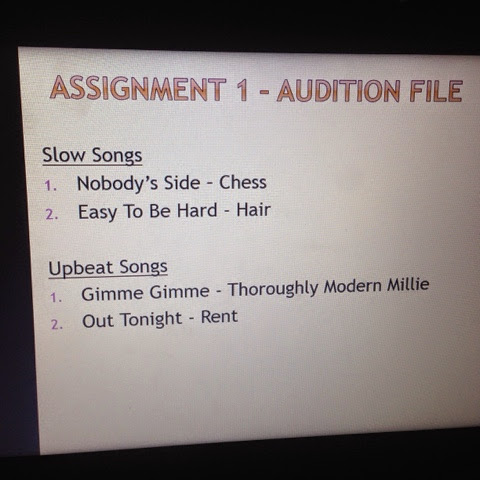
PRESENTATION: https://www.youtube.com/watch?v=2hZWYKfd6HI&feature=youtu.be
Bibliography:
In post http://cstraker.blogspot.co.uk/2014/10/assignment-1-pab-drama-schools-unis.html:
- CSSD (2014) Acting (Musical Theatre), BA. Available from: http://www.cssd.ac.uk/course/acting-musical-theatre-ba (Accessed on: 1st October 2014)
- Arts Ed (2014) Musical Theatre: BA: Course Overview. Available from: http://artsed.co.uk/musical-theatre/musical-theatre-ba-course-overview (Accessed on: 1st October 2014)
- Mountview (2014) BA (Hons) in Performance - Musical Theatre/Diploma. Available from: http://www.mountview.org.uk/performance/musical-theatre (Accessed on: 1st October 2014)
- University of West London (2014) BA (Hons) Musical Theatre. Available from: http://www.uwl.ac.uk/course/musical-theatre/31757 (Accessed on 1st October 2014)
- University of Surrey (2014) Musical Theatre BA (Hons) - 2015 Entry. Available from: http://www.surrey.ac.uk/undergraduate/musical-theatre (Accessed on 1st October 2014)
- Trinity Laban (2014) BA (Hons) Musical Theatre Performance. Available from: http://www.trinitylaban.ac.uk/study/music/ba-hons-musical-theatre-performance (Accessed on 1st October 2014)
- University of West London (2014) Music Performance, Composition and Musical Theatre Facilities. Available from: http://www.uwl.ac.uk/academic-schools/music/facilities/music-performance-composition-and-musical-theatre-facilities (Accessed on: 1st October 2014)
- Disney Careers (2014) Application Process. Available from: http://disneycareers.co.uk/en/faq/application-process/ (Accessed on: 17th October 2014)
- West End Wendy Blog (7th August 2011) Front of House Commandments. Available from: http://westendwendyblog.wordpress.com/2011/08/07/front-of-house-commandments/ (Acessed on: 17th October 2014)
- Essortment (2011) Career Help: How To Become A Casting Director. Available from: http://www.essortment.com/career-become-casting-director-37246.html (Accessed on: 5th November 2014)
- Jobs AOL (3rd March 2010) Confessions of a Casting Director. Available from: http://jobs.aol.com/articles/2010/03/03/confessions-of-a-casting-director/ (Accessed on: 5th November 2014)
- Production Base (4th November 2014) Casting Assistant Producers. Casting Researcher. Available from: http://www.productionbase.co.uk/film-tv-jobs/casting-assistant-producers-11.14.0083892 , http://www.productionbase.co.uk/film-tv-jobs/casting-researcher-11.14.0083893 (Accessed on: 5th November 2014)
- Prospects (May 2014) Make-up artist: Job description. Available from: http://www.prospects.ac.uk/make_up_artist_job_description.htm (Accessed on: 10th November 2014)
- National Careers Service (2012) Make-up artist Job Information. Available from: https://nationalcareersservice.direct.gov.uk/advice/planning/jobprofiles/Pages/make-upartist.aspx (Accessed on: 10th November 2014)
- Karla Powell Make-up Artist (1st November 2014) Half Skull Make-up Katie Price. Available from: http://www.karlapowell.co.uk/post/101480738912/katie-price-makeup-artist-katie-price-halloween-makeup (Accessed on: 10th November 2014)
- Karla Powell Make-up Artist (2012) Magnum Ice-Cream. Available from: http://karlapowellmua.prosite.com/91803/3759946/gallery/magnum-ice-cream (Accessed on: 10th November 2014)
- Indeed (5th November 2014) Makeup Artist Full-time. Available from: http://www.indeed.co.uk/cmp/NARS-Cosmetics/jobs/Makeup-Artist-Full-Time-e9a6426699702260 (Accessed on: 10th November 2014)
- Reed (30th October 2014) Beauty Consultant for Luxury Brand. Available from: http://www.reed.co.uk/jobs/beauty-consultant-for-luxury-brand/25917672?WT.mc_id=indeed (Accessed on: 10th November 2014)
Music Notes (2014):
- "Easy To Be Hard" from HAIR. Available from: http://www.musicnotes.com/sheetmusic/mtdFPE.asp?ppn=MN0054821 (Accessed on 14th November 2014)
- "In L.A. from 'Fame: The Musical'. Available from: http://www.musicnotes.com/sheetmusic/mtdFPE.asp?ppn=MN0061593 (Accessed on 14th November 2014)
- "I'm the Greatest Star" from Funny Girl. Available from: http://www.musicnotes.com/sheetmusic/mtdFPE.asp?ppn=MN0044279 (Accessed on 14th November 2014)
- "Out Tonight" from 'Rent'. Available from: http://www.musicnotes.com/sheetmusic/mtdFPE.asp?ppn=MN0044279 (Accessed on 14th November 2014)
In PAB Slideshow:
Headshots Slide
Headshots Slide
- Florida Atlantic University (2005) Uni News. Available from: http://www.fau.edu/marketing/internal/update/archive/06Dec/univnews.html (Accessed 4th December 2014)
- Pinterest. Modelling Ideas. Available from: https://www.pinterest.com/pin/491596115546835004/ (Accessed 4th December 2014)
Companies Slide
- Spotlight. About Us. Available from: http://www.spotlight.com/aboutus/whatwedo.html (Accessed on 4th December 2014)
- Equity. About Us. Available from: http://www.equity.org.uk/about-us/ (Accessed on 4th December 2014)
- Casting Call Pro. About. Available from: http://www.castingcallpro.com/uk/about.php (Accessed on 4th December 2014)
- BECTU. About Us. Available from: https://www.bectu.org.uk/about (Accessed on 4th December 2014)
- ITC. About Us. Available from: http://www.itc-arts.org/about-us (Accessed on 4th December 2014)
- Showtec. Sound, Lighting and Visual. Available from: http://www.showtec.co.uk/sound-lighting-visual/sound.html (Accessed on 4th December 2014)
- Confused.com. Public Liability Insurance. Available from: http://www.confused.com/small-business-insurance/guides/understanding-public-liability-insurance (Accessed on 4th December 2014)
- Harveys of Hove. Available from: http://www.harveysofhove.co.uk/ (Acessed on 4th December 2014)
Funding Slide
- Differences Between Public And Private Sources of Funding. Available from: http://literacy.kent.edu/Oasis/grants/publicVSprivate.html (Accessed on 4th December 2014)
- Arts & Business. About us. Available from: http://artsandbusiness.bitc.org.uk/about-ab (Accessed on 4th December 2014)
- Lottery Good Causes. Grants for the arts. Available from: http://www.lotterygoodcauses.org.uk/funding/grants-arts (Accessed on 4th December 2014)
















